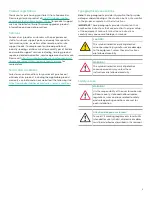
Chapter 3. Software
3.1 Overall architecture
All flare.IQ software applications run a real-time operating
system (RTOS) for embedded devices. As described in
the following section, all analog inputs from the flare
flow meter, steam/air flow meter, and online analyzer are
received from the DCS via Modbus/TCP. On startup, the
RTOS automatically starts the flare.IQ core software, the
embedded web server, and the web console application.
The flare.IQ core is a component architecture of separate
processes that perform the flare control and meter
validation data acquisition and processing, a dedicated
Modbus/TCP server, and components for verifying license
status and user permissions.
The web console application is a browser-hosted interface
that can be opened by a single authorized user connected
to the flare.IQ via LAN A (Ethernet 1). It is used for configuring
the flare.IQ during initial set-up and commissioning. It
can also be used to monitor the functionality of flare.IQ
during operation.
3.2 Functional description
3.2.1 Flare control
The flare control software algorithm uses the speed
of sound measured by Panametrics’ ultrasonic flare flow
meter to estimate the molecular weight of the vent gas
between updates from an optional online analyzer such as
a gas chromatograph, mass spectrometer or calorimeter.
The calculated molecular weight, vent gas flow, and
fuel flow are then used to estimate the net heating value
of the vent gas (NHV
vg
). The net heating value is used to
control the supplemental fuel gas flow (fuel gas valve
demand to the DCS). The steam/air assist demand is a
function of the molecular weight of the hydrocarbons
in the vent gas and the flare flow. The system also
calculates the NHV in the combustion zone. The
high-level process logic flow diagram is shown in
figure 8 below.
Figure 8: High-level flare control process logic flow
Flare inputs
Flow
Pressure
Temperature
Sound speed
Calculate fuel
flow demand
Calculate steam
flow demand
Flare inputs
Flow
GC/MS inputs
XH2, XN2, XCO2, XCO, XAr,
XH2O, NHVVG, MW
Estimate the molecular weight
Estimate the vent gas net heating value
Steam inputs
Flow
Pressure
Temperature
Outputs
Steam demand
Fuel demand
Tip velocity
NHVCZ
15
Summary of Contents for flare.IQ Generation 2
Page 1: ...flare IQ Generation 2 Operation and maintenance manual...
Page 2: ...2...
Page 3: ...flare IQ Generation 2 Operation and maintenance manual 910 350 rev A June 2020 3...
Page 4: ...no content intended for this page 4...
Page 38: ...Figure 30 System wiring diagram 38...
Page 48: ...48...
















































